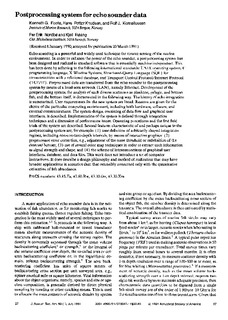| dc.description.abstract | Echo sounding is a powerful and widely used technique for remote sensing of the marine environment. In order to enhance the power of the echo sounder, a postprocessing system has been designed and realized in standard software that is essentially machine independent. This has been done by adhering to the following international standards: UNIX operating system, C programming language, X Window Systems, Structured-Query Language (SQL) for communication with a relational database, and Transport Control Protocol/Internet Protocol (TCP/IP). Preprocessed data are transferred from the echo sounder to the postprocessing system by means of a local-area network (LAN), namely Ethernet. Development of the postprocessing system, for analysis of such diverse scatterers as plankton, pelagic, and bottom fish, and the bottom itself, is documented in the following way. The history of echo integration is summarized. User requirements for the new system are listed. Reasons are given for the choice of the particular computing environment, including both hardware, software, and external communications. The system design, consisting of data flow and graphical user interfaces, is described. Implementation of the system is defined through integration techniques and a discussion of performance issues. Operating procedures and the first field trials of the system are described. Several features characteristic of and perhaps unique to the postprocessing system are, for example: (1) user definition of arbitrarily shaped integration regions, including non-constant-depth intervals, by means of interactive graphics; (2) preprocessor error correction, e.g., adjustment of the noise threshold or redefinition of the detected bottom; (3) use of several color map techniques in order to extract such information as signal strength and shape; and (4) the scheme of interconnections of graphical user interfaces, database, and data files. This work does not introduce a set of computer instructions. It does describe a design philosophy and method of realization that may have broader applications in acoustics than that ostensibly concerned only with the quantitative estimation of fish abundance. | en |
